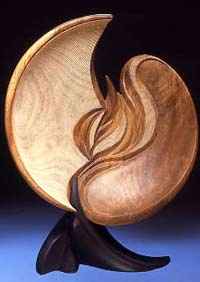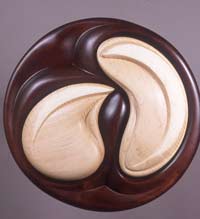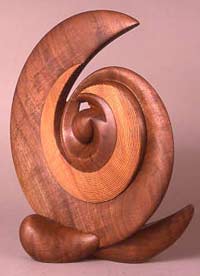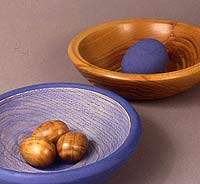
To Betty Scarpino, turning wood is as easy as turning a phrase, and she does both quite well. A former editor of the AAW Journal (American Association of Woodturners) and a full-time turner and wood carver, Betty has parlayed a three-decade love affair with words, wood and lathes into a satisfying career. It is a mix so entwined that wordplay both shows up in the titles of some of her unusual pieces, and at times is the inspiration for them.
The best news is that we’re poised to hear much more from her. She has recently agreed to shoulder the mantle of contributing editor for turning in our sister print magazine, Woodworker’s Journal, to which I offer a hearty and heartfelt “Welcome aboard!” Even that elicited an interesting comment from Betty. “The difference between the print magazine and the eZine,” she said, “is the difference between Sunday dinner and dim sum. Both can be very satisfying. It is a matter of which you prefer.”
Betty’s cellulose odyssey started in 1975 when she took a night class in woodworking, just for fun, at the University of Missouri. At the time, she was working as a computer programmer. “I pretty much hated programming,” she said, “so I had incentive to do something different. I switched from working full-time to part-time, and got my degree in industrial arts from University of Missouri. By then, I realized that I wanted to do woodworking.”

While at UM, she was the shop supervisor in their student services lounge woodshop, and was also part of a co-op gallery with potters, weavers and a papermaker. “That was my first venue, and I sold bowls, cutting boards, baby rattles: the usual craft fair fodder.
“We moved to Texas while I was pregnant with my first child, and I rented some space from a cabinetmaker in exchange for buying him a lathe.” It was a three-speed Hegner spindle lathe, a company for whom she later did demos. “When I left, I bought the lathe back from the guy, thus paying for it twice.”
“Gradually, I started switching to woodworking full-time, a change that took place slowly from 1975 to 1990. The real link to turning came in Texas, where I met the first editor of the AAW newsletter in 1986. I gave him a turning lesson. Four years later, I took over the editorship of the magazine, and edited it for three years.”

It is less than surprising that much of her turning appears to also be a base for carving. “Turning was the one aspect of woodworking that I could fit into my life. I did not single it out, but it fit. For me, carving is the thing that I really enjoy more than anything.”
Working with a design philosophy that says, “make it look like you meant to do what you just did,” her carved and turned creations are frequently intertwined with wordplay. She takes curious word games and turns them into visual conceptualizations.
A conceptual piece called ‘Blue Egg Bowl’ is a good example. “If I were to say ‘I am making a blue egg bowl,’ that could mean a bowl for blue eggs, or a blue bowl for eggs, or a blue, egg-shaped bowl. So I made one of each, and the three comprise one montage. It consists of a brown bowl with one blue egg in it, a blue bowl with brown eggs in it, and a turned egg mounted sideways and turned again to make it into a blue, egg-shaped bowl.”
‘Stepping Out of Line,’ which made it onto the catalog cover of an AAW exhibition called Growth Through Sharing, reveals a different play on words. “The title refers to two different things,” Betty explained; “adding color to cover up the wood grain, and cutting and carving. In the turning field, painting or cutting apart turned objects was considered by many to be a sacrilege, and it was for me, too. It was a real statement that I was stepping out of line.”

Another example is her piece ‘Containing Desire,’ which both captures desire and contains it. “That can mean either I am containing my desires, or the piece contains my desires. If you say ‘contain yourself,’ it means something different than saying ‘these cookies contain nuts.'”
I asked her which came first, the word game or the piece it inhabits, and the answer revealed just how indelible that connection is. “Blue Egg Bowl was one of the few pieces where the pun came first,” she said. “In other cases, the title comes while I am working on a piece, or just after it is done. I often find that when I can’t find a title for a piece, those tend to be the pieces that are not successful.”
Some of her pieces have names that both reflect their intent, and reveal information about their maker. “‘Reverberations; was the first piece I turned on my new lathe, in my new house, after my divorce. It was a statement about all the things others have done for me that affected my life in a good way. Like ripples in a pond, it reflects that effect. ‘Stepping out of Line,’ ‘In Lieu of Housework,’ and ‘Blue Egg Bowl’ all contain something about me that people can pick up on and connect with.”
“If you are successful at making art,” she continued, “you put a part of yourself into it. When you really connect, it shows. My best pieces connect to things happening in my life, and the viewer picks up on that. Those are the ones to which people are drawn.”
As is often the case with artists, limitations can spawn creativity, and such was the case with Scarpino. “My lathe only turned twelve inches in diameter, and that was a real limitation for me. At the time, very big and very little pieces were getting noticed. I made my work look bigger by creating a stand as a part of the piece.” Thus was born her ‘Altered plate’ series, whose turnings are both altered, and altared: both changed, and set upon an altar.

Along the way, she has shared her abilities with others, teaching at Arrowmont, the Center for Furniture Craftsmanship, Anderson Ranch, and the Wooden Boat School in Maine, and is scheduled to teach this year at the Marc Adams School. She has been chosen to be the first artist-in-residence at the new Center for Turning and Furniture in Indiana, Pennsylvania, the first turning program at an art school. She also received a creative renewal grant from the Indianapolis Arts Council, one of fifty $7,500 grants given by the Lilly Endowment every other year to people in the arts. She points out that the grant program has infused the Indiana art community with energy, money and enthusiasm for art.
At the end of the day, though, it is the turning and carving that provide Betty with her greatest joy.
“The thrill I get out of making something is what it is all about. I’m happiest when I’m out there in my studio working, and the chips are flying.”





